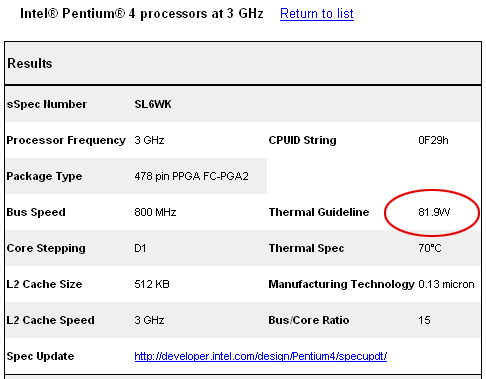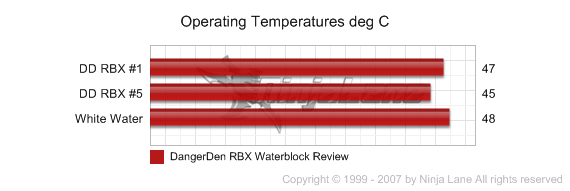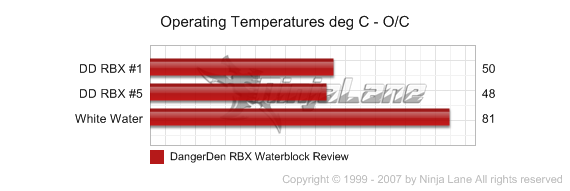After careful consideration I have decided to transfer all hardware review activities to a new domain. I purchased Hardwareasylum.com in 2012 and have been working hard to build a new and improved Ninjalane on that domain. If you are reading this you have reached one of the archived articles, news, projects and/or reviews that were left behind during the site migration.
Please update your bookmarks and be sure to visit the new and improved Ninjalane at Hardwareasylum.com
DangerDen RBX Waterblock Review
Author: Dennis Garcia
Published: Saturday, February 21, 2004
Benchmarks
The Danger Den RBX is installable on AthlonXP, Athlon64, and Pentium 4 processors running at any speed with performance and overclocking in mind. Here is an overview of the system and testing methodology.
The system as it was tested
Abit IS7-G
Intel Pentium 4 3.0C 800Mhz FSB (SL6WK)
Danger Den RBX
Dtek White Water
The watercooling system consisted of a Hydor L30 pump, Black Ice Pro radiator, Sunon 120mm fan (running 7v), and a small reservoir for water storage and air collection. 3/8" I.D. hose was used throughout with minimum hose lengths used whenever possible.
Motherboard Monitor was used to obtain and record system temperature information and a game of Halo provided the 100% processor usage.
Intel Pentium 4 3.0C 800Mhz FSB (SL6WK)
Danger Den RBX
Dtek White Water
The watercooling system consisted of a Hydor L30 pump, Black Ice Pro radiator, Sunon 120mm fan (running 7v), and a small reservoir for water storage and air collection. 3/8" I.D. hose was used throughout with minimum hose lengths used whenever possible.
Motherboard Monitor was used to obtain and record system temperature information and a game of Halo provided the 100% processor usage.
Editors note: Even though the Windows XP task manager reported 100% processor usage we could never attain a 100% of the rated heat output as documented by Intel (see below)
when using Halo as a basis for that heat production. Knowing this the game was played until the maximum temperature was attainted and stabilized, or when the round was over.
Other things to consider when judging software induced heat output.
a) Clock throttling by the processor at high temperatures.
b) Normal software isn't designed to produce maximum heat output.
c) Variances of cooling temperature.
d) Variances in CPU load.
e) Inaccuracies in thermal diode readouts.
Of course the list goes on..
My testing methodology is aimed to provide a real world look into this waterblock given the test system provided.
a) Clock throttling by the processor at high temperatures.
b) Normal software isn't designed to produce maximum heat output.
c) Variances of cooling temperature.
d) Variances in CPU load.
e) Inaccuracies in thermal diode readouts.
Of course the list goes on..
My testing methodology is aimed to provide a real world look into this waterblock given the test system provided.

Default Processor Speed and Vo

A C/W rating can quickly be calculated using this formula.
C/W = (CPU temp - Ambient temp)/(Variance(%) * CPU Watts)
Allowed variance for this test = 90%
CPU Watts = 81.9W
0.30 C/W = (47C - 25C)/(.9(81.9W)) - [Using the default acceleration nozzle (#1)]
C/W = (CPU temp - Ambient temp)/(Variance(%) * CPU Watts)
Allowed variance for this test = 90%
CPU Watts = 81.9W
0.30 C/W = (47C - 25C)/(.9(81.9W)) - [Using the default acceleration nozzle (#1)]

For this next test we cranked the FSB up to 235Mhz and re-ran the tests. To calculate how the C/W rating has changed we will need to factor in the increased processor
wattage. The formula and constants for this are listed below.
ocC/W = dCPU Watts * (ocMhz / dMhz) * (ocVcore / dVcore)2
ocMhz = 3525
dMhz = 3000
ocVcore = 1.65
dVcore = 1.55
The variance still applies for our C/W calcuation
Allowed variance for this test = 90%
CPU Watts = 108.7W
0.26C/W = (50C - 25C)/(.9(108.7W)) - [Using the default acceleration nozzle (#1)]
ocC/W = dCPU Watts * (ocMhz / dMhz) * (ocVcore / dVcore)2
ocMhz = 3525
dMhz = 3000
ocVcore = 1.65
dVcore = 1.55
The variance still applies for our C/W calcuation
Allowed variance for this test = 90%
CPU Watts = 108.7W
0.26C/W = (50C - 25C)/(.9(108.7W)) - [Using the default acceleration nozzle (#1)]
Benchmark Conclusion
Normally in a test like this the C/W rating will go up or remain the same to indicate that the heat transfer efficiency has reached its limit. In this case the number has gone down showing that the Danger Den RBX can be even more efficient with different jetting or a higher capacity radiator and/or pump. This theory was reaffirmed by the secondary results using the #5 nozzle.
Keep in mind this calculation is provided for demonstration purposes only and may not reflect the actual lab tested C/W rating, but I think I'm close
Keep in mind this calculation is provided for demonstration purposes only and may not reflect the actual lab tested C/W rating, but I think I'm close

